Comprehensive Literature Review Report on Workplace Equality
VerifiedAdded on 2020/10/23
|14
|2619
|287
Report
AI Summary
This report presents a literature review on the concept of equality in the workplace. It begins by defining literature review and its purpose within research, emphasizing its role in identifying research gaps and justifying methodologies. The report then focuses on workplace equality, examining various perspectives on fair treatment, equal opportunities, and the impact of discrimination based on factors like gender, age, and religion. It explores arguments for and against strict equality, considering its effects on organizational culture, employee motivation, and the challenges of implementation. The review highlights the importance of clear anti-discrimination policies, the benefits of a diverse workforce, and the role of globalization in shaping workplace dynamics. The conclusion stresses the importance of a strong knowledge base for research studies and the complexities of ensuring equality in the workplace, suggesting a balance between equality and performance-based recognition. This report is a great resource for students and researchers to understand the complexities of workplace equality.
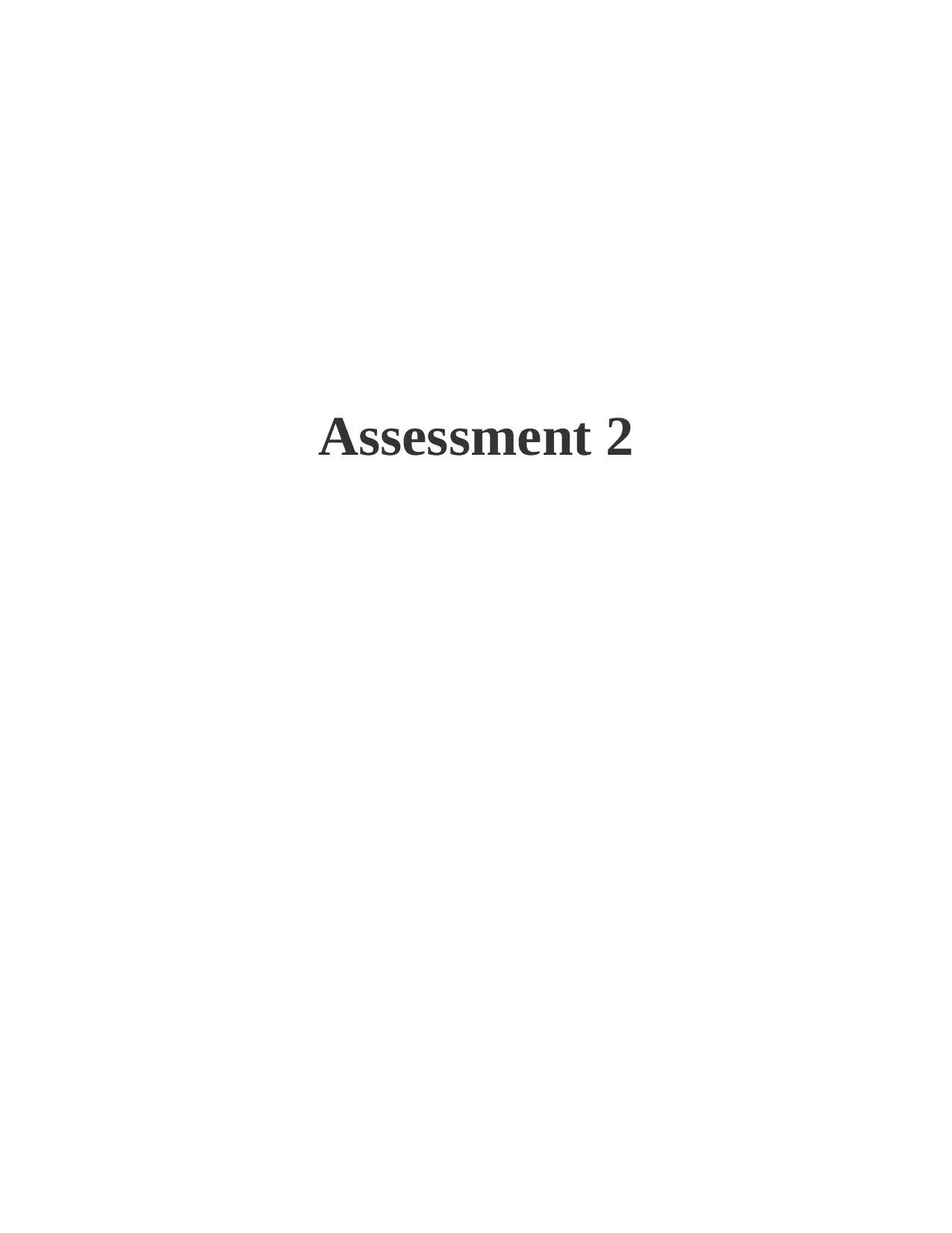
Assessment 2
Paraphrase This Document
Need a fresh take? Get an instant paraphrase of this document with our AI Paraphraser
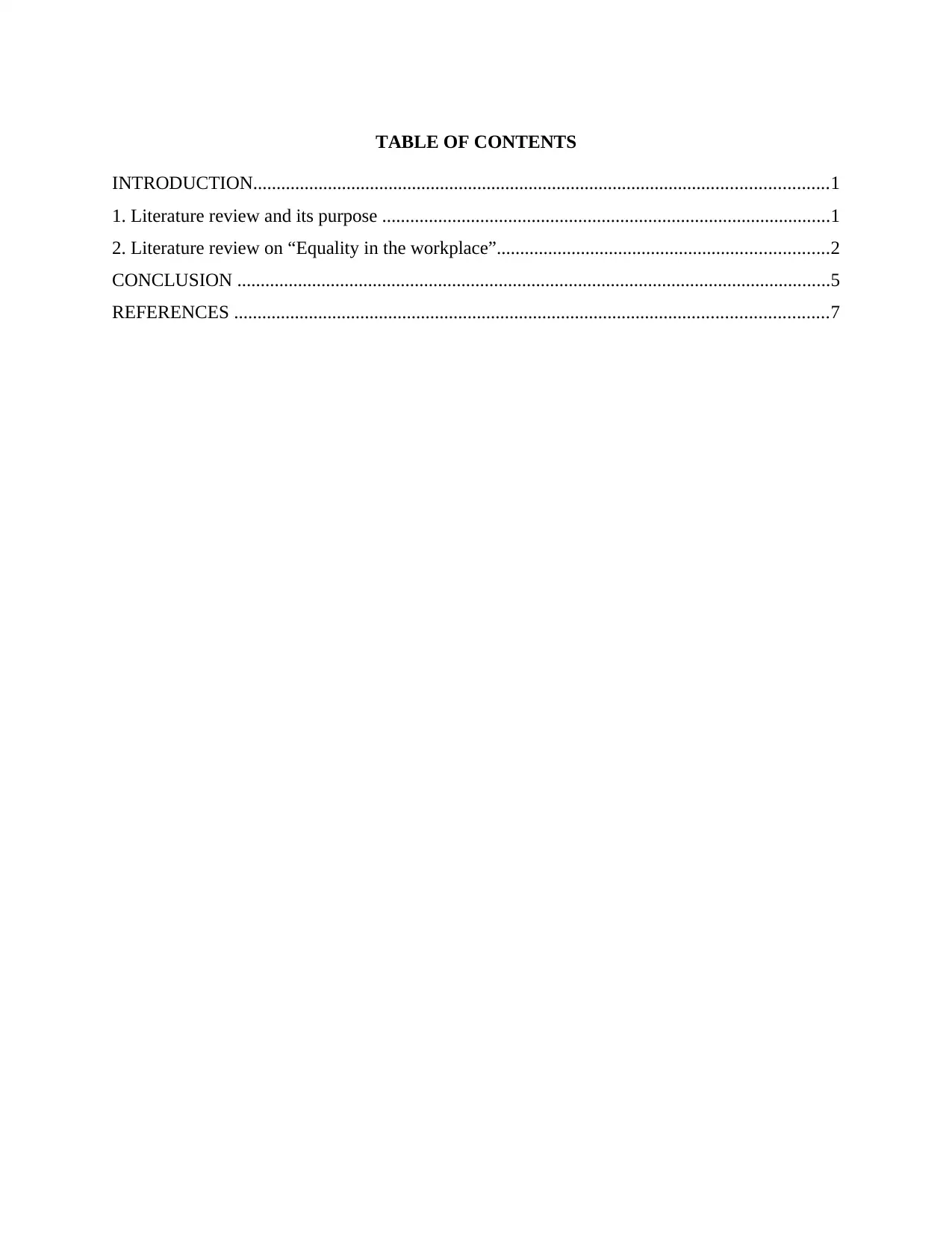
TABLE OF CONTENTS
INTRODUCTION...........................................................................................................................1
1. Literature review and its purpose ................................................................................................1
2. Literature review on “Equality in the workplace”.......................................................................2
CONCLUSION ...............................................................................................................................5
REFERENCES ...............................................................................................................................7
INTRODUCTION...........................................................................................................................1
1. Literature review and its purpose ................................................................................................1
2. Literature review on “Equality in the workplace”.......................................................................2
CONCLUSION ...............................................................................................................................5
REFERENCES ...............................................................................................................................7

INTRODUCTION
Literature review is defined as the compressive and organized analysis of secondary
sources such as books, journals and scholarly articles so that basic knowledge regarding research
topic can be developed. Literature review is one of the essential part of the research studies
because it helps to justify the existing research gaps included in the study (Machi and McEvoy,
2016). The report will discuss the meaning and purpose of literature review. It will also discuss
the significance of literature review in making the research studies successful. Further the
document will also demonstrate the understanding of critical review by presenting a literature
review on workplace equality.
1. Literature review and its purpose
Literature review can be defined as the analysis or evaluation of the knowledge which is
established by the authors and researchers in specific study area. It helps researchers to achieve
expertise so that on a particular research subject efficiency and in-depth knowledge can be
achieved. Literature review also allows sharpening of research skills so that valid and unbiased
research data can be identified and analysed. This type of review allows researchers to
understand the theories, vocabulary and various research variables with the help of work of
influential researchers in the same study context.
One of the benefit of conducting a literature review is that it helps to discover and explore
the academic opinion which is agreed by other scholars while at the same instant it allows
researchers to also analyse the disagreements related to the topic (Bolívar and Meijer, 2016).
Literature review is also known as the narrative review which demonstrates the methodological
and theoretical contributions as well as substantive conclusions to specific topic.
Thus, this review type can be considered as the secondary source analysis which only
evaluate the existing knowledge instead of determining any new experimental work. Since the
relevance and originality of the research problem is demonstrated by literature review, it also
justifies the research methodology. Literature search also demonstrates that how the current
study or the research subject fits within larger research field. The critical review helps readers as
well as researchers to direct the research objective. These reviews are included and executed in
the beginning of the research study so that existing research gaps can be highlighted and work
can be continued to fill those empty gaps in the study.
1
Literature review is defined as the compressive and organized analysis of secondary
sources such as books, journals and scholarly articles so that basic knowledge regarding research
topic can be developed. Literature review is one of the essential part of the research studies
because it helps to justify the existing research gaps included in the study (Machi and McEvoy,
2016). The report will discuss the meaning and purpose of literature review. It will also discuss
the significance of literature review in making the research studies successful. Further the
document will also demonstrate the understanding of critical review by presenting a literature
review on workplace equality.
1. Literature review and its purpose
Literature review can be defined as the analysis or evaluation of the knowledge which is
established by the authors and researchers in specific study area. It helps researchers to achieve
expertise so that on a particular research subject efficiency and in-depth knowledge can be
achieved. Literature review also allows sharpening of research skills so that valid and unbiased
research data can be identified and analysed. This type of review allows researchers to
understand the theories, vocabulary and various research variables with the help of work of
influential researchers in the same study context.
One of the benefit of conducting a literature review is that it helps to discover and explore
the academic opinion which is agreed by other scholars while at the same instant it allows
researchers to also analyse the disagreements related to the topic (Bolívar and Meijer, 2016).
Literature review is also known as the narrative review which demonstrates the methodological
and theoretical contributions as well as substantive conclusions to specific topic.
Thus, this review type can be considered as the secondary source analysis which only
evaluate the existing knowledge instead of determining any new experimental work. Since the
relevance and originality of the research problem is demonstrated by literature review, it also
justifies the research methodology. Literature search also demonstrates that how the current
study or the research subject fits within larger research field. The critical review helps readers as
well as researchers to direct the research objective. These reviews are included and executed in
the beginning of the research study so that existing research gaps can be highlighted and work
can be continued to fill those empty gaps in the study.
1
⊘ This is a preview!⊘
Do you want full access?
Subscribe today to unlock all pages.

Trusted by 1+ million students worldwide
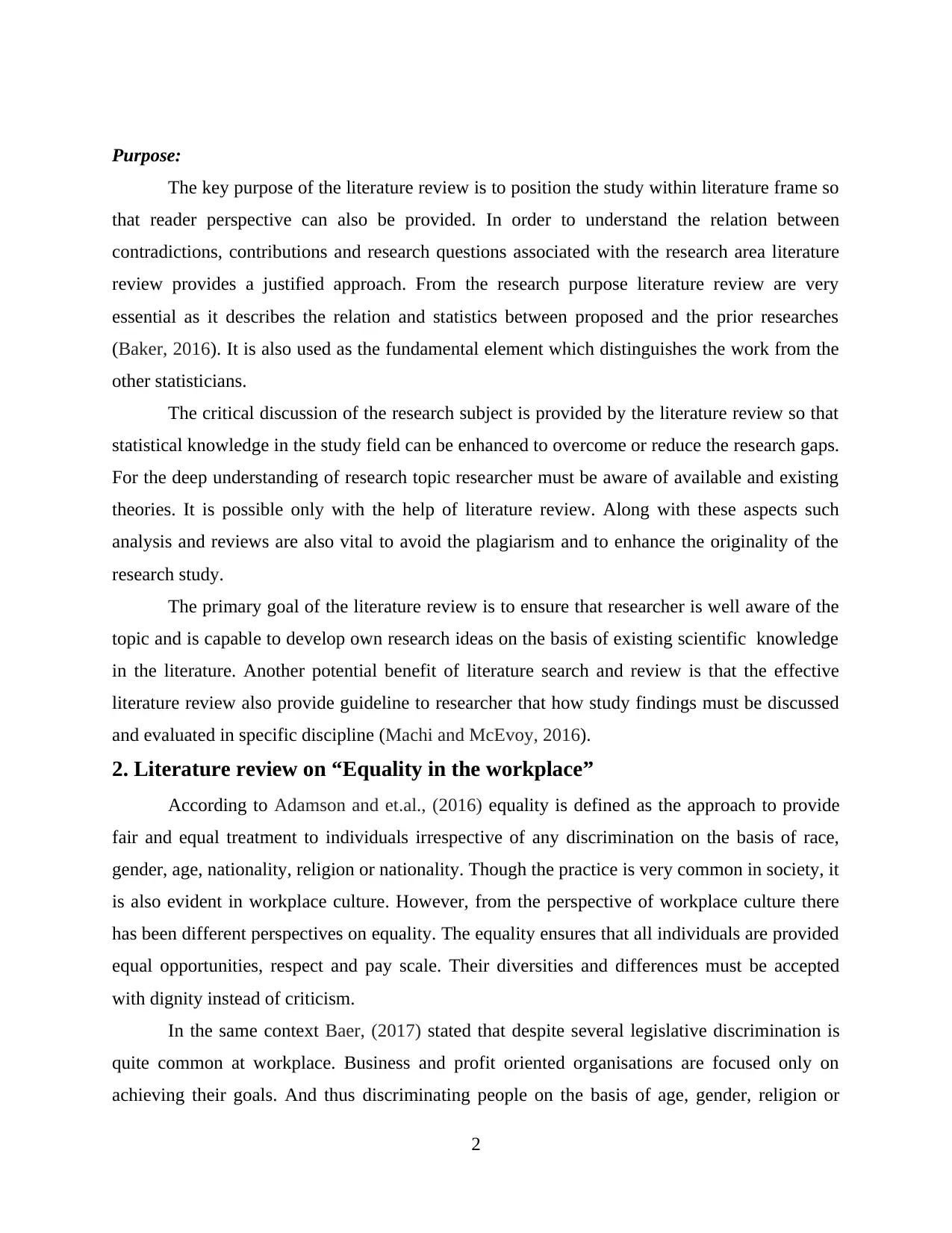
Purpose:
The key purpose of the literature review is to position the study within literature frame so
that reader perspective can also be provided. In order to understand the relation between
contradictions, contributions and research questions associated with the research area literature
review provides a justified approach. From the research purpose literature review are very
essential as it describes the relation and statistics between proposed and the prior researches
(Baker, 2016). It is also used as the fundamental element which distinguishes the work from the
other statisticians.
The critical discussion of the research subject is provided by the literature review so that
statistical knowledge in the study field can be enhanced to overcome or reduce the research gaps.
For the deep understanding of research topic researcher must be aware of available and existing
theories. It is possible only with the help of literature review. Along with these aspects such
analysis and reviews are also vital to avoid the plagiarism and to enhance the originality of the
research study.
The primary goal of the literature review is to ensure that researcher is well aware of the
topic and is capable to develop own research ideas on the basis of existing scientific knowledge
in the literature. Another potential benefit of literature search and review is that the effective
literature review also provide guideline to researcher that how study findings must be discussed
and evaluated in specific discipline (Machi and McEvoy, 2016).
2. Literature review on “Equality in the workplace”
According to Adamson and et.al., (2016) equality is defined as the approach to provide
fair and equal treatment to individuals irrespective of any discrimination on the basis of race,
gender, age, nationality, religion or nationality. Though the practice is very common in society, it
is also evident in workplace culture. However, from the perspective of workplace culture there
has been different perspectives on equality. The equality ensures that all individuals are provided
equal opportunities, respect and pay scale. Their diversities and differences must be accepted
with dignity instead of criticism.
In the same context Baer, (2017) stated that despite several legislative discrimination is
quite common at workplace. Business and profit oriented organisations are focused only on
achieving their goals. And thus discriminating people on the basis of age, gender, religion or
2
The key purpose of the literature review is to position the study within literature frame so
that reader perspective can also be provided. In order to understand the relation between
contradictions, contributions and research questions associated with the research area literature
review provides a justified approach. From the research purpose literature review are very
essential as it describes the relation and statistics between proposed and the prior researches
(Baker, 2016). It is also used as the fundamental element which distinguishes the work from the
other statisticians.
The critical discussion of the research subject is provided by the literature review so that
statistical knowledge in the study field can be enhanced to overcome or reduce the research gaps.
For the deep understanding of research topic researcher must be aware of available and existing
theories. It is possible only with the help of literature review. Along with these aspects such
analysis and reviews are also vital to avoid the plagiarism and to enhance the originality of the
research study.
The primary goal of the literature review is to ensure that researcher is well aware of the
topic and is capable to develop own research ideas on the basis of existing scientific knowledge
in the literature. Another potential benefit of literature search and review is that the effective
literature review also provide guideline to researcher that how study findings must be discussed
and evaluated in specific discipline (Machi and McEvoy, 2016).
2. Literature review on “Equality in the workplace”
According to Adamson and et.al., (2016) equality is defined as the approach to provide
fair and equal treatment to individuals irrespective of any discrimination on the basis of race,
gender, age, nationality, religion or nationality. Though the practice is very common in society, it
is also evident in workplace culture. However, from the perspective of workplace culture there
has been different perspectives on equality. The equality ensures that all individuals are provided
equal opportunities, respect and pay scale. Their diversities and differences must be accepted
with dignity instead of criticism.
In the same context Baer, (2017) stated that despite several legislative discrimination is
quite common at workplace. Business and profit oriented organisations are focused only on
achieving their goals. And thus discriminating people on the basis of age, gender, religion or
2
Paraphrase This Document
Need a fresh take? Get an instant paraphrase of this document with our AI Paraphraser
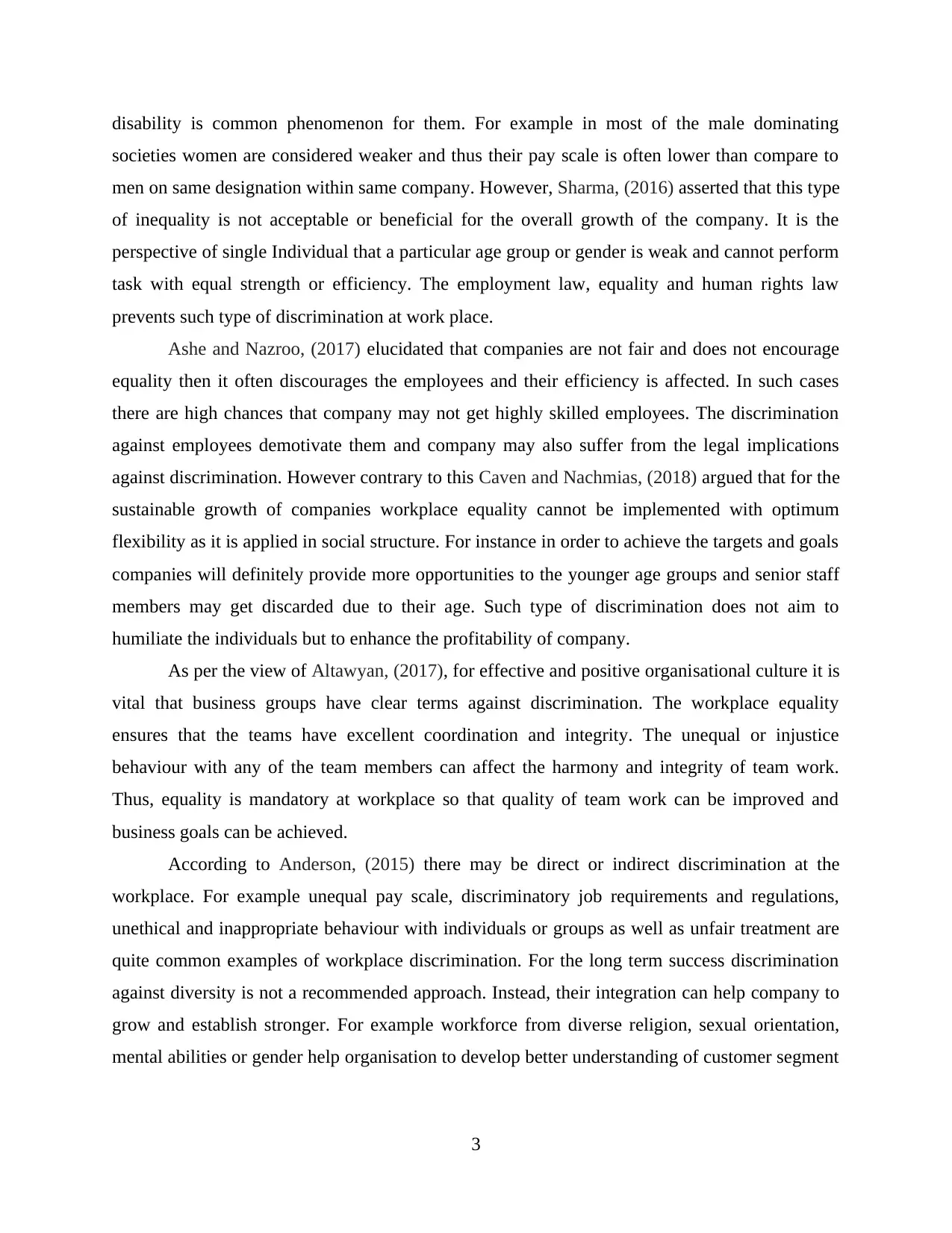
disability is common phenomenon for them. For example in most of the male dominating
societies women are considered weaker and thus their pay scale is often lower than compare to
men on same designation within same company. However, Sharma, (2016) asserted that this type
of inequality is not acceptable or beneficial for the overall growth of the company. It is the
perspective of single Individual that a particular age group or gender is weak and cannot perform
task with equal strength or efficiency. The employment law, equality and human rights law
prevents such type of discrimination at work place.
Ashe and Nazroo, (2017) elucidated that companies are not fair and does not encourage
equality then it often discourages the employees and their efficiency is affected. In such cases
there are high chances that company may not get highly skilled employees. The discrimination
against employees demotivate them and company may also suffer from the legal implications
against discrimination. However contrary to this Caven and Nachmias, (2018) argued that for the
sustainable growth of companies workplace equality cannot be implemented with optimum
flexibility as it is applied in social structure. For instance in order to achieve the targets and goals
companies will definitely provide more opportunities to the younger age groups and senior staff
members may get discarded due to their age. Such type of discrimination does not aim to
humiliate the individuals but to enhance the profitability of company.
As per the view of Altawyan, (2017), for effective and positive organisational culture it is
vital that business groups have clear terms against discrimination. The workplace equality
ensures that the teams have excellent coordination and integrity. The unequal or injustice
behaviour with any of the team members can affect the harmony and integrity of team work.
Thus, equality is mandatory at workplace so that quality of team work can be improved and
business goals can be achieved.
According to Anderson, (2015) there may be direct or indirect discrimination at the
workplace. For example unequal pay scale, discriminatory job requirements and regulations,
unethical and inappropriate behaviour with individuals or groups as well as unfair treatment are
quite common examples of workplace discrimination. For the long term success discrimination
against diversity is not a recommended approach. Instead, their integration can help company to
grow and establish stronger. For example workforce from diverse religion, sexual orientation,
mental abilities or gender help organisation to develop better understanding of customer segment
3
societies women are considered weaker and thus their pay scale is often lower than compare to
men on same designation within same company. However, Sharma, (2016) asserted that this type
of inequality is not acceptable or beneficial for the overall growth of the company. It is the
perspective of single Individual that a particular age group or gender is weak and cannot perform
task with equal strength or efficiency. The employment law, equality and human rights law
prevents such type of discrimination at work place.
Ashe and Nazroo, (2017) elucidated that companies are not fair and does not encourage
equality then it often discourages the employees and their efficiency is affected. In such cases
there are high chances that company may not get highly skilled employees. The discrimination
against employees demotivate them and company may also suffer from the legal implications
against discrimination. However contrary to this Caven and Nachmias, (2018) argued that for the
sustainable growth of companies workplace equality cannot be implemented with optimum
flexibility as it is applied in social structure. For instance in order to achieve the targets and goals
companies will definitely provide more opportunities to the younger age groups and senior staff
members may get discarded due to their age. Such type of discrimination does not aim to
humiliate the individuals but to enhance the profitability of company.
As per the view of Altawyan, (2017), for effective and positive organisational culture it is
vital that business groups have clear terms against discrimination. The workplace equality
ensures that the teams have excellent coordination and integrity. The unequal or injustice
behaviour with any of the team members can affect the harmony and integrity of team work.
Thus, equality is mandatory at workplace so that quality of team work can be improved and
business goals can be achieved.
According to Anderson, (2015) there may be direct or indirect discrimination at the
workplace. For example unequal pay scale, discriminatory job requirements and regulations,
unethical and inappropriate behaviour with individuals or groups as well as unfair treatment are
quite common examples of workplace discrimination. For the long term success discrimination
against diversity is not a recommended approach. Instead, their integration can help company to
grow and establish stronger. For example workforce from diverse religion, sexual orientation,
mental abilities or gender help organisation to develop better understanding of customer segment
3
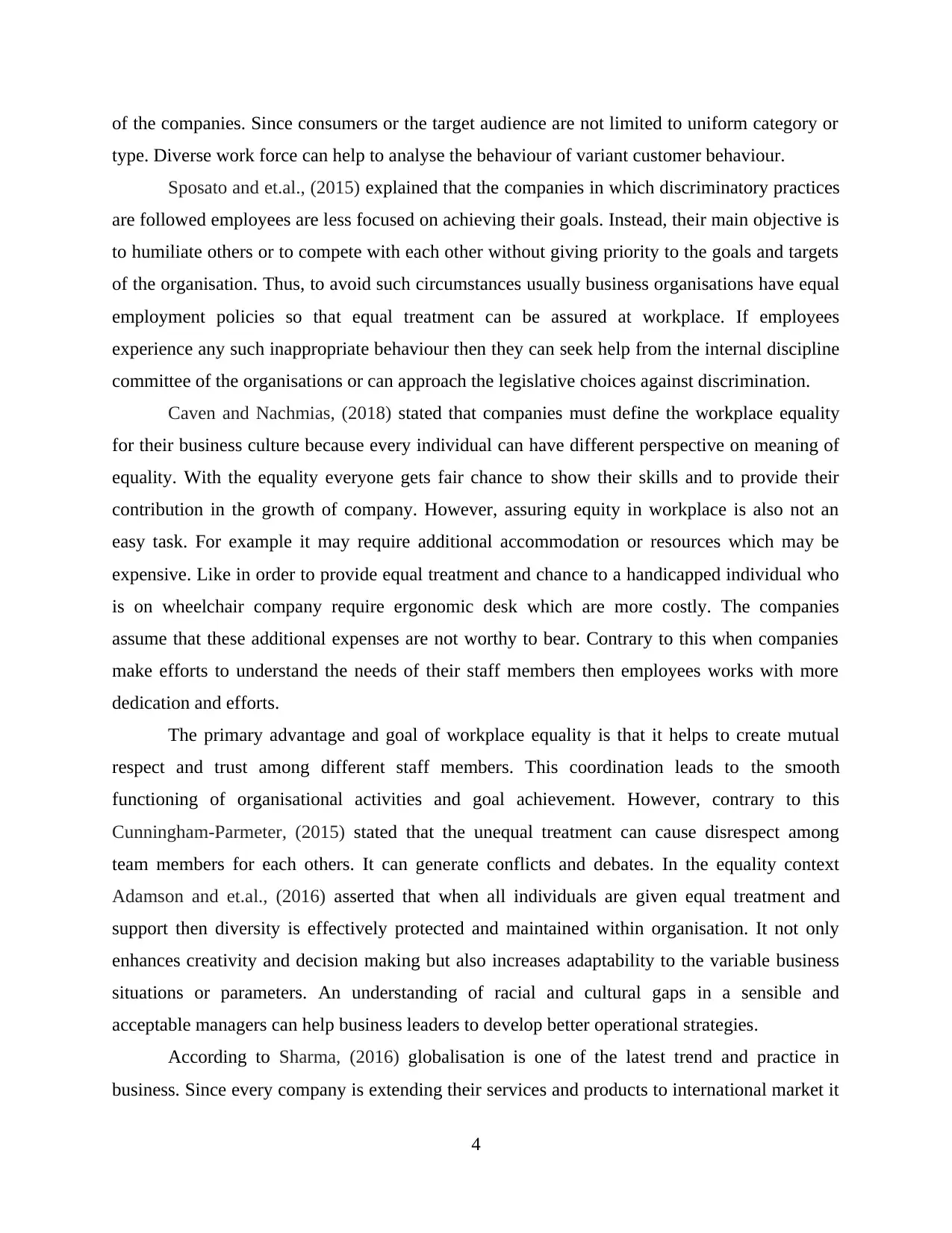
of the companies. Since consumers or the target audience are not limited to uniform category or
type. Diverse work force can help to analyse the behaviour of variant customer behaviour.
Sposato and et.al., (2015) explained that the companies in which discriminatory practices
are followed employees are less focused on achieving their goals. Instead, their main objective is
to humiliate others or to compete with each other without giving priority to the goals and targets
of the organisation. Thus, to avoid such circumstances usually business organisations have equal
employment policies so that equal treatment can be assured at workplace. If employees
experience any such inappropriate behaviour then they can seek help from the internal discipline
committee of the organisations or can approach the legislative choices against discrimination.
Caven and Nachmias, (2018) stated that companies must define the workplace equality
for their business culture because every individual can have different perspective on meaning of
equality. With the equality everyone gets fair chance to show their skills and to provide their
contribution in the growth of company. However, assuring equity in workplace is also not an
easy task. For example it may require additional accommodation or resources which may be
expensive. Like in order to provide equal treatment and chance to a handicapped individual who
is on wheelchair company require ergonomic desk which are more costly. The companies
assume that these additional expenses are not worthy to bear. Contrary to this when companies
make efforts to understand the needs of their staff members then employees works with more
dedication and efforts.
The primary advantage and goal of workplace equality is that it helps to create mutual
respect and trust among different staff members. This coordination leads to the smooth
functioning of organisational activities and goal achievement. However, contrary to this
Cunningham-Parmeter, (2015) stated that the unequal treatment can cause disrespect among
team members for each others. It can generate conflicts and debates. In the equality context
Adamson and et.al., (2016) asserted that when all individuals are given equal treatment and
support then diversity is effectively protected and maintained within organisation. It not only
enhances creativity and decision making but also increases adaptability to the variable business
situations or parameters. An understanding of racial and cultural gaps in a sensible and
acceptable managers can help business leaders to develop better operational strategies.
According to Sharma, (2016) globalisation is one of the latest trend and practice in
business. Since every company is extending their services and products to international market it
4
type. Diverse work force can help to analyse the behaviour of variant customer behaviour.
Sposato and et.al., (2015) explained that the companies in which discriminatory practices
are followed employees are less focused on achieving their goals. Instead, their main objective is
to humiliate others or to compete with each other without giving priority to the goals and targets
of the organisation. Thus, to avoid such circumstances usually business organisations have equal
employment policies so that equal treatment can be assured at workplace. If employees
experience any such inappropriate behaviour then they can seek help from the internal discipline
committee of the organisations or can approach the legislative choices against discrimination.
Caven and Nachmias, (2018) stated that companies must define the workplace equality
for their business culture because every individual can have different perspective on meaning of
equality. With the equality everyone gets fair chance to show their skills and to provide their
contribution in the growth of company. However, assuring equity in workplace is also not an
easy task. For example it may require additional accommodation or resources which may be
expensive. Like in order to provide equal treatment and chance to a handicapped individual who
is on wheelchair company require ergonomic desk which are more costly. The companies
assume that these additional expenses are not worthy to bear. Contrary to this when companies
make efforts to understand the needs of their staff members then employees works with more
dedication and efforts.
The primary advantage and goal of workplace equality is that it helps to create mutual
respect and trust among different staff members. This coordination leads to the smooth
functioning of organisational activities and goal achievement. However, contrary to this
Cunningham-Parmeter, (2015) stated that the unequal treatment can cause disrespect among
team members for each others. It can generate conflicts and debates. In the equality context
Adamson and et.al., (2016) asserted that when all individuals are given equal treatment and
support then diversity is effectively protected and maintained within organisation. It not only
enhances creativity and decision making but also increases adaptability to the variable business
situations or parameters. An understanding of racial and cultural gaps in a sensible and
acceptable managers can help business leaders to develop better operational strategies.
According to Sharma, (2016) globalisation is one of the latest trend and practice in
business. Since every company is extending their services and products to international market it
4
⊘ This is a preview!⊘
Do you want full access?
Subscribe today to unlock all pages.

Trusted by 1+ million students worldwide
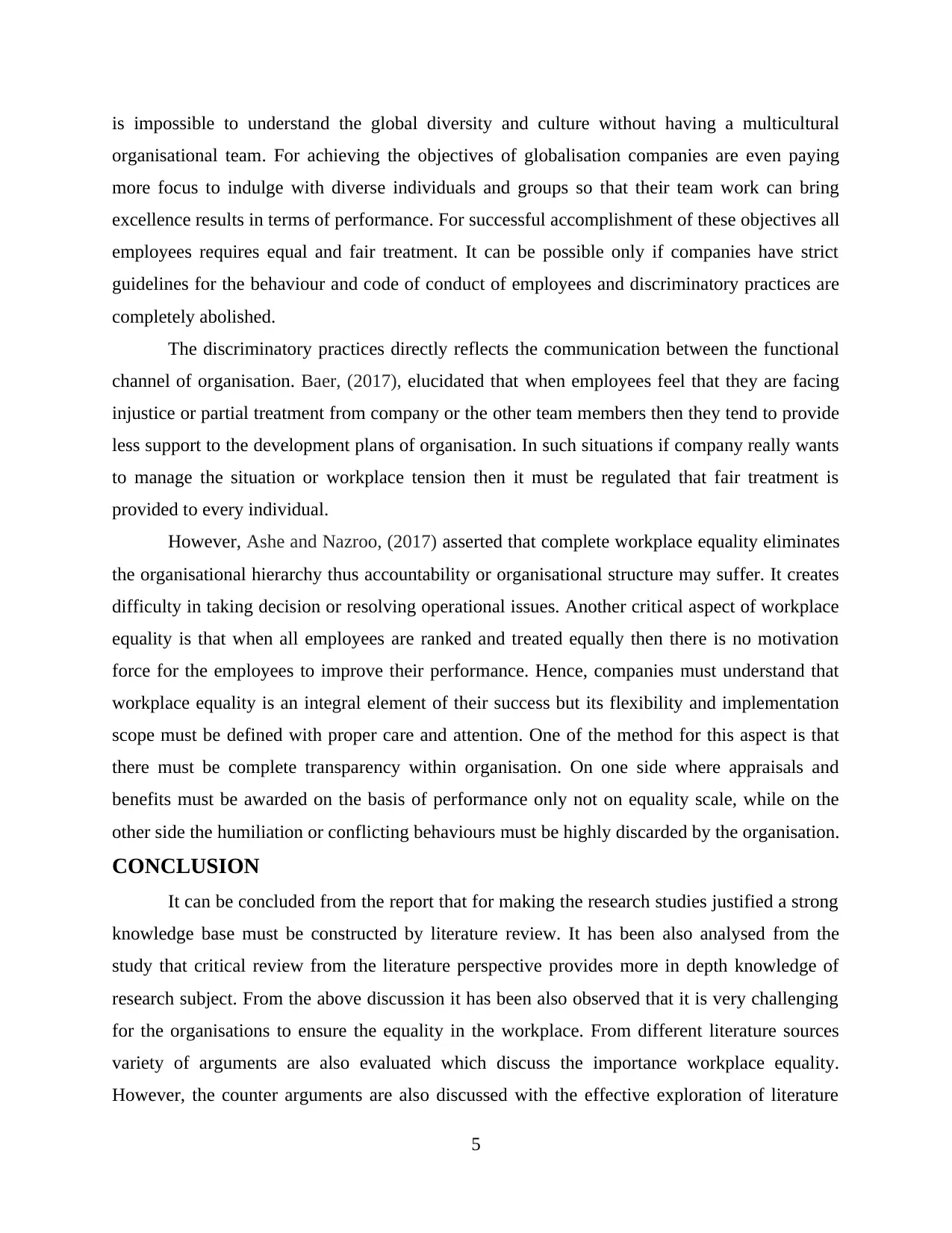
is impossible to understand the global diversity and culture without having a multicultural
organisational team. For achieving the objectives of globalisation companies are even paying
more focus to indulge with diverse individuals and groups so that their team work can bring
excellence results in terms of performance. For successful accomplishment of these objectives all
employees requires equal and fair treatment. It can be possible only if companies have strict
guidelines for the behaviour and code of conduct of employees and discriminatory practices are
completely abolished.
The discriminatory practices directly reflects the communication between the functional
channel of organisation. Baer, (2017), elucidated that when employees feel that they are facing
injustice or partial treatment from company or the other team members then they tend to provide
less support to the development plans of organisation. In such situations if company really wants
to manage the situation or workplace tension then it must be regulated that fair treatment is
provided to every individual.
However, Ashe and Nazroo, (2017) asserted that complete workplace equality eliminates
the organisational hierarchy thus accountability or organisational structure may suffer. It creates
difficulty in taking decision or resolving operational issues. Another critical aspect of workplace
equality is that when all employees are ranked and treated equally then there is no motivation
force for the employees to improve their performance. Hence, companies must understand that
workplace equality is an integral element of their success but its flexibility and implementation
scope must be defined with proper care and attention. One of the method for this aspect is that
there must be complete transparency within organisation. On one side where appraisals and
benefits must be awarded on the basis of performance only not on equality scale, while on the
other side the humiliation or conflicting behaviours must be highly discarded by the organisation.
CONCLUSION
It can be concluded from the report that for making the research studies justified a strong
knowledge base must be constructed by literature review. It has been also analysed from the
study that critical review from the literature perspective provides more in depth knowledge of
research subject. From the above discussion it has been also observed that it is very challenging
for the organisations to ensure the equality in the workplace. From different literature sources
variety of arguments are also evaluated which discuss the importance workplace equality.
However, the counter arguments are also discussed with the effective exploration of literature
5
organisational team. For achieving the objectives of globalisation companies are even paying
more focus to indulge with diverse individuals and groups so that their team work can bring
excellence results in terms of performance. For successful accomplishment of these objectives all
employees requires equal and fair treatment. It can be possible only if companies have strict
guidelines for the behaviour and code of conduct of employees and discriminatory practices are
completely abolished.
The discriminatory practices directly reflects the communication between the functional
channel of organisation. Baer, (2017), elucidated that when employees feel that they are facing
injustice or partial treatment from company or the other team members then they tend to provide
less support to the development plans of organisation. In such situations if company really wants
to manage the situation or workplace tension then it must be regulated that fair treatment is
provided to every individual.
However, Ashe and Nazroo, (2017) asserted that complete workplace equality eliminates
the organisational hierarchy thus accountability or organisational structure may suffer. It creates
difficulty in taking decision or resolving operational issues. Another critical aspect of workplace
equality is that when all employees are ranked and treated equally then there is no motivation
force for the employees to improve their performance. Hence, companies must understand that
workplace equality is an integral element of their success but its flexibility and implementation
scope must be defined with proper care and attention. One of the method for this aspect is that
there must be complete transparency within organisation. On one side where appraisals and
benefits must be awarded on the basis of performance only not on equality scale, while on the
other side the humiliation or conflicting behaviours must be highly discarded by the organisation.
CONCLUSION
It can be concluded from the report that for making the research studies justified a strong
knowledge base must be constructed by literature review. It has been also analysed from the
study that critical review from the literature perspective provides more in depth knowledge of
research subject. From the above discussion it has been also observed that it is very challenging
for the organisations to ensure the equality in the workplace. From different literature sources
variety of arguments are also evaluated which discuss the importance workplace equality.
However, the counter arguments are also discussed with the effective exploration of literature
5
Paraphrase This Document
Need a fresh take? Get an instant paraphrase of this document with our AI Paraphraser
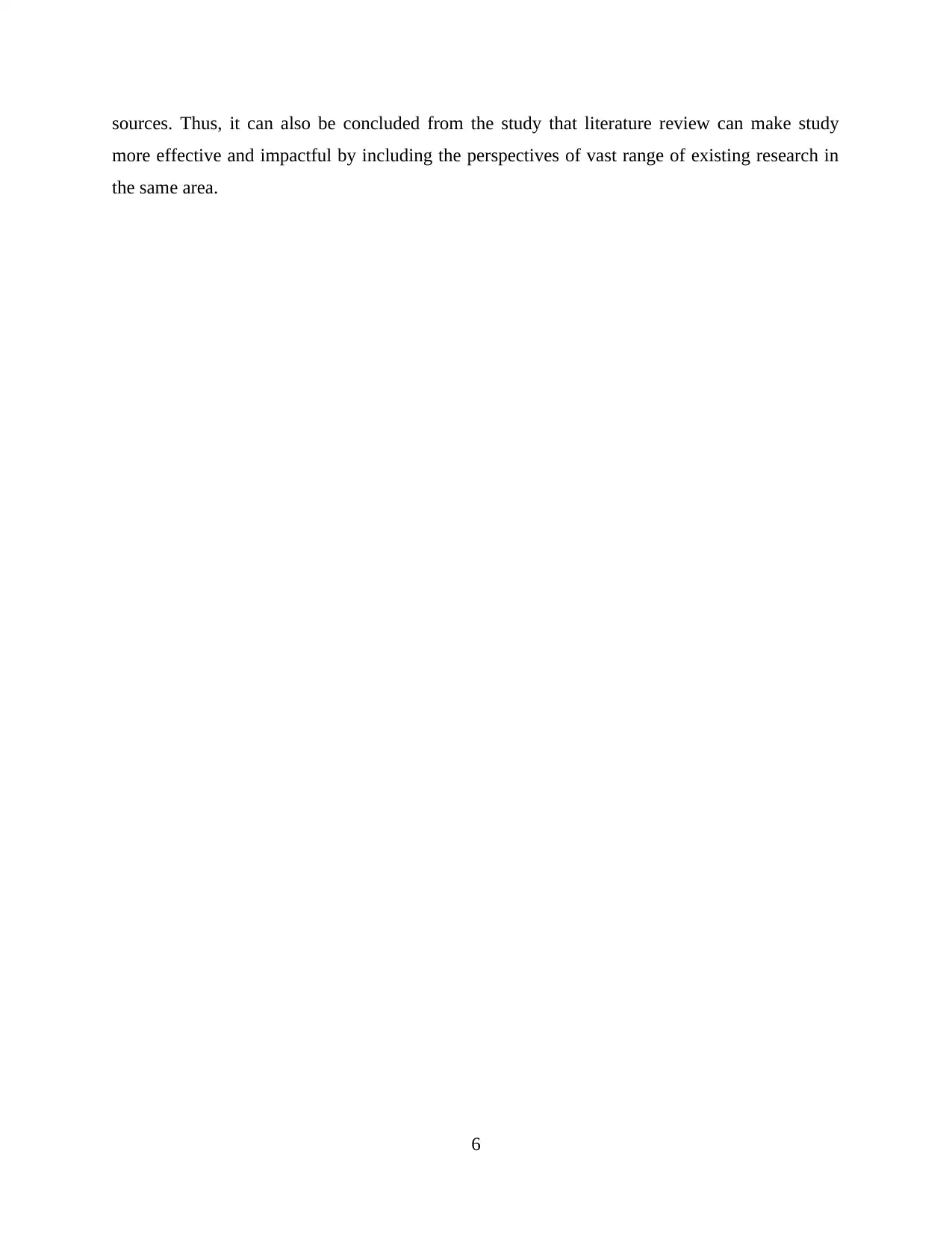
sources. Thus, it can also be concluded from the study that literature review can make study
more effective and impactful by including the perspectives of vast range of existing research in
the same area.
6
more effective and impactful by including the perspectives of vast range of existing research in
the same area.
6
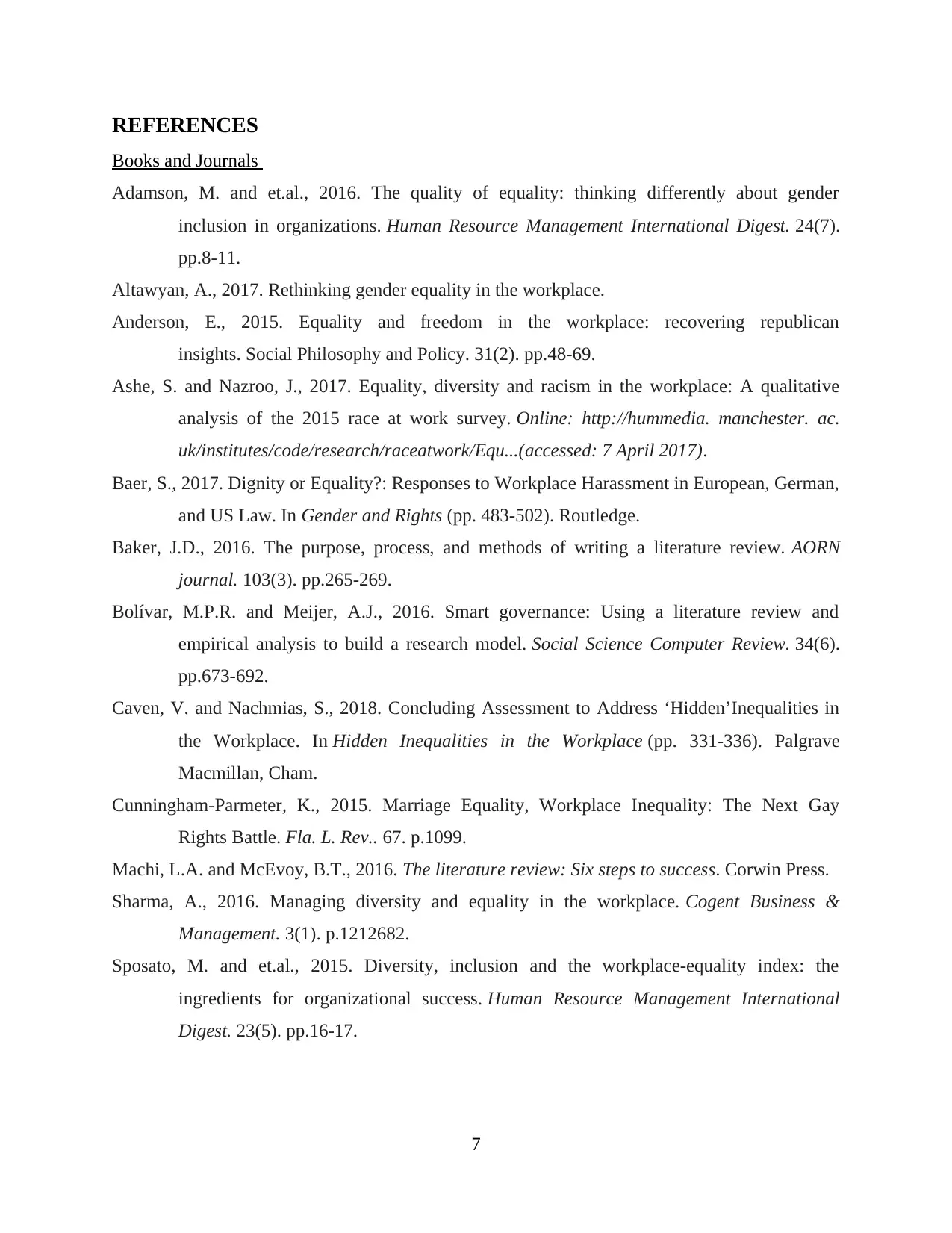
REFERENCES
Books and Journals
Adamson, M. and et.al., 2016. The quality of equality: thinking differently about gender
inclusion in organizations. Human Resource Management International Digest. 24(7).
pp.8-11.
Altawyan, A., 2017. Rethinking gender equality in the workplace.
Anderson, E., 2015. Equality and freedom in the workplace: recovering republican
insights. Social Philosophy and Policy. 31(2). pp.48-69.
Ashe, S. and Nazroo, J., 2017. Equality, diversity and racism in the workplace: A qualitative
analysis of the 2015 race at work survey. Online: http://hummedia. manchester. ac.
uk/institutes/code/research/raceatwork/Equ...(accessed: 7 April 2017).
Baer, S., 2017. Dignity or Equality?: Responses to Workplace Harassment in European, German,
and US Law. In Gender and Rights (pp. 483-502). Routledge.
Baker, J.D., 2016. The purpose, process, and methods of writing a literature review. AORN
journal. 103(3). pp.265-269.
Bolívar, M.P.R. and Meijer, A.J., 2016. Smart governance: Using a literature review and
empirical analysis to build a research model. Social Science Computer Review. 34(6).
pp.673-692.
Caven, V. and Nachmias, S., 2018. Concluding Assessment to Address ‘Hidden’Inequalities in
the Workplace. In Hidden Inequalities in the Workplace (pp. 331-336). Palgrave
Macmillan, Cham.
Cunningham-Parmeter, K., 2015. Marriage Equality, Workplace Inequality: The Next Gay
Rights Battle. Fla. L. Rev.. 67. p.1099.
Machi, L.A. and McEvoy, B.T., 2016. The literature review: Six steps to success. Corwin Press.
Sharma, A., 2016. Managing diversity and equality in the workplace. Cogent Business &
Management. 3(1). p.1212682.
Sposato, M. and et.al., 2015. Diversity, inclusion and the workplace-equality index: the
ingredients for organizational success. Human Resource Management International
Digest. 23(5). pp.16-17.
7
Books and Journals
Adamson, M. and et.al., 2016. The quality of equality: thinking differently about gender
inclusion in organizations. Human Resource Management International Digest. 24(7).
pp.8-11.
Altawyan, A., 2017. Rethinking gender equality in the workplace.
Anderson, E., 2015. Equality and freedom in the workplace: recovering republican
insights. Social Philosophy and Policy. 31(2). pp.48-69.
Ashe, S. and Nazroo, J., 2017. Equality, diversity and racism in the workplace: A qualitative
analysis of the 2015 race at work survey. Online: http://hummedia. manchester. ac.
uk/institutes/code/research/raceatwork/Equ...(accessed: 7 April 2017).
Baer, S., 2017. Dignity or Equality?: Responses to Workplace Harassment in European, German,
and US Law. In Gender and Rights (pp. 483-502). Routledge.
Baker, J.D., 2016. The purpose, process, and methods of writing a literature review. AORN
journal. 103(3). pp.265-269.
Bolívar, M.P.R. and Meijer, A.J., 2016. Smart governance: Using a literature review and
empirical analysis to build a research model. Social Science Computer Review. 34(6).
pp.673-692.
Caven, V. and Nachmias, S., 2018. Concluding Assessment to Address ‘Hidden’Inequalities in
the Workplace. In Hidden Inequalities in the Workplace (pp. 331-336). Palgrave
Macmillan, Cham.
Cunningham-Parmeter, K., 2015. Marriage Equality, Workplace Inequality: The Next Gay
Rights Battle. Fla. L. Rev.. 67. p.1099.
Machi, L.A. and McEvoy, B.T., 2016. The literature review: Six steps to success. Corwin Press.
Sharma, A., 2016. Managing diversity and equality in the workplace. Cogent Business &
Management. 3(1). p.1212682.
Sposato, M. and et.al., 2015. Diversity, inclusion and the workplace-equality index: the
ingredients for organizational success. Human Resource Management International
Digest. 23(5). pp.16-17.
7
⊘ This is a preview!⊘
Do you want full access?
Subscribe today to unlock all pages.

Trusted by 1+ million students worldwide

8
Paraphrase This Document
Need a fresh take? Get an instant paraphrase of this document with our AI Paraphraser

9

10
⊘ This is a preview!⊘
Do you want full access?
Subscribe today to unlock all pages.

Trusted by 1+ million students worldwide
1 out of 14
Related Documents
Your All-in-One AI-Powered Toolkit for Academic Success.
+13062052269
info@desklib.com
Available 24*7 on WhatsApp / Email
![[object Object]](/_next/static/media/star-bottom.7253800d.svg)
Unlock your academic potential
Copyright © 2020–2025 A2Z Services. All Rights Reserved. Developed and managed by ZUCOL.



